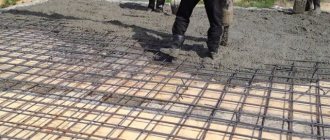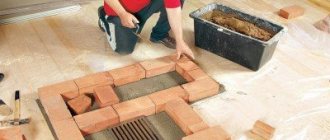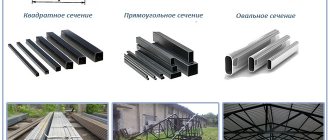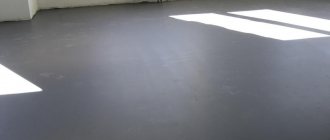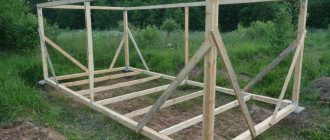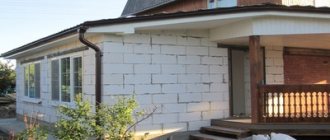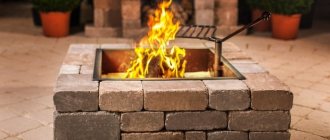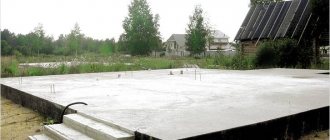Any concrete is a mixture of binders and aggregates. Depending on the proportion of the “ingredients”, the result is fatty, normal or lean concrete. The latter type has a denser consistency due to the smaller proportion of water and cement. In addition, when preparing lean mixtures, a larger amount of coarse and fine crushed stone is used.
Despite its name, such concrete is very popular and is widely used in construction. It has a high degree of homogeneity, which allows you to complete work much faster (the mixture hardens very quickly). You can easily make this material yourself and use it for various types of work.
Where to begin?
- First of all, you should buy high-quality, fresh binder (cement) of the M400 or M500 brand, which corresponds to the brand declared by the manufacturer. The practice of construction work shows that the cement produced by Novoroscement OJSC fully meets all declared strength indicators. You can also use special self-expanding cement used at drilling stations;
- Secondly, it is necessary to carefully prepare the filler - river or quarry sand. The sand should not contain any foreign impurities. There are shells and pebbles in the river sand. Quarry sand contains admixtures of clay and soil. In this regard, it is enough to sift river sand through a fine sieve, but quarry sand will have to be washed with water and dried;
- Thirdly, the solution should be reinforced. As a rule, fine asbestos is used for this - 0.1 or 1 part to 1 part cement. Previously, waste from wool washing machines along with chicken eggs was used for these purposes. This “hellish” mixture was added to masonry or plaster mortar during the construction of Orthodox churches. The resulting structure was so strong that heavy German shells and bombs did not take it.
Transportation Features
The simplest way to deliver the solution to the work site is transportation in dump trucks. No other type of concrete is suitable for this type of transportation. The disadvantage of the dump truck is its large dimensions; it is not always possible to transport the mixture to the site. The easiest way to form a base with lean concrete is to order a ready-made solution. Specialized companies probably adhere to the preparation proportions and mix the mixture thoroughly. At the transportation stage, it is important to prevent drying out and waterlogging of the solution, since both conditions reduce the quality of concrete.
The easiest way to transport solution from place to place is transportation using dump trucks
Recipes for strong cement mortar
- Plastering wet rooms: cement M400-500 – 1 part, lime paste – 0.5 parts, purified sand – 2 or 4 parts, fine asbestos – 1 part;
- Plastering hydraulic structures (swimming pools, caissons, laying ceramic tiles, etc.): cement M400-500 – 1 part, clay – 0.1-0.2 parts, ceresite – 0.12 parts, sand from 2 to 3 parts parts;
- Plastering dry rooms: cement M400-500 – 1 part, sawdust – 3 parts, sand – 1 part, grout – lime milk;
- Masonry mortar: 1 part M400-500 cement and 2 parts prepared sand. A structure built with such a solution can withstand a powerful explosion.
To summarize it is necessary about. In other words, “strong cement mortar” costs much more than a standard cement-sand mortar of a commonly used brand. Therefore, before spending additional money on “mortar strength”, it is worth weighing the need for such a step and consulting with specialists in the field of construction technologies in your region.
Cement proportions for masonry
They say that what is built cheaply and cheerfully rests only on your word of honor. Let's not do that. Let's approach the process consciously.
We will mix the sand-cement mixture from the following materials:
- cement M400;
- clean sand;
- water;
- lime.
Lime is used to “insulate joints.” In general, sometimes masonry mortar is prepared from limestone to build warm houses. But the disadvantage of this composition is low strength. But if you mix cement and lime together, you get a durable composition with good thermal insulation properties.
The following tables show the proportions of components for mixing per 1 m3.
The proportions of the sand-lime mixture in shares for the M75 solution look like this:
- 1 part cement M400;
- 0.5 tsp lime;
- 5.5 hours of sand.
And if you use M500 cement, the components are taken in the following ratio:
- 1 tsp cement powder;
- 0.8 tsp lime;
- 7 hours of sand.
What additives need to be added to cement and their characteristics
Cement additives are used everywhere in construction today: special substances make it possible to improve various characteristics and properties, and increase the mechanical properties of concrete mortar for various purposes. Polymer and plasticizing, modifying compositions can make the concrete mixture more plastic and practical to work with, resistant to water or frost, increase strength, etc.
Most cement additives greatly facilitate the process of laying the mortar and its compaction, thus reducing labor and financial costs. Can be used in the production of concrete structures, mortars, elements of any strength level. The most popular additives for cement today are: concrete set retarders/accelerators, anti-frost, for waterproofing, air-entraining, stabilizing, etc.
Scope of application
Since lean concrete has low strength, it is most often used as an auxiliary component, for example, for:
- construction of bases for road surfaces, sidewalks and other asphalt areas;
- erection of foundations;
- processing of seams of foundations;
- construction of preparation (layer up to 10 cm) for pile foundations;
- arrangement of screeds and concrete pads up to 9 cm high;
- preparation of foundations for swimming pools;
- installation of floors in the soil.
However, it is worth considering that the scope of use of lean concrete is determined by the ratio of its components.
Additives for cement mortar and concrete
Most often, special additives are used in construction to increase the strength of highly loaded concrete structures. Hydrophobic compounds that improve frost resistance are popular. Basically, they are added directly to the mixed concrete mortar, which is used immediately after preparation.
After the setting and hardening processes are completed, solutions with additives demonstrate additional performance characteristics - resistance to corrosion, sub-zero temperatures, water, increased bending/compressive strength, etc. The use of additives is advisable in certain situations, taking into account the high price of concrete and mortar with additives mixed into it.
The use of cement additives is relevant:
- In the production of highly loaded reinforced concrete products, these can be foundation blocks, for example
- If concrete has increased requirements for resistance to water/frost
- When materials of non-standard fractions are chosen as a filler - fine sand, for example
- If there is a need to mix fine-grained concrete mortar
- In the construction of monolithic structures and buildings where expanding additives are used
What it is
Skinny concrete is a construction mixture that differs from standard and fatty ones in its reduced content of cement (binder). In this case, fillers (for example, crushed stone) are used in larger quantities. The result of this combination is high rigidity of the solution, so when laying concrete of this type, several rules should be followed.
Concrete containing a small amount of cement is not suitable for all types of construction work. This factor is important to consider, because otherwise, the quality of the construction project may deteriorate.
Types of additives
When thinking about what to add to cement for strength, it is necessary to carefully consider all existing types of additives, study their properties, determine the feasibility of using certain compositions, calculate the expected loads and other key points.
Strength accelerators
Additives of this type increase the speed of setting and hardening of the concrete mixture and, accordingly, significantly increase the compressive and bending strength in comparison with brand indicators. The most popular and affordable strength gain accelerator is ordinary calcium chloride. It is used in the production of foam concrete blocks, various types of blocks for foundations and walls, polystyrene concrete, etc.
Plasticizers
These cement additives are considered the best, as they can increase the strength of a structure or monolith by 125-140% on average, which is a very good result. The main task of plasticizers is to increase the mobility of the concrete mixture.
This additive to cement mortar for strength also demonstrates excellent properties in terms of frost resistance and improves other characteristics: on average, the frost resistance of a concrete mortar increases by 1.5 grades, moisture impermeability by 4 grades, and binder consumption is reduced by about a quarter. The most popular homemade plasticizers are ordinary washing powder and ordinary liquid soap.
With anti-frost effect
This type of additive allows you to carry out work on preparing and pouring concrete at low temperatures - down to -25C. Concrete improves its strength characteristics, the level of water resistance increases, the finished concrete delaminates less during transportation, and is much lighter and easier to lay. The simplest version of an anti-frost solution is neutralized resin mixed with a water repellent such as Tiprom-S, for example (you can also take Sofexil-gel).
Material properties
Now let's look at the properties of lean concrete. The concrete class is designated by the letter B - it shows the strength of concrete in megapascals. Simply put, it talks about how much weight 1 cm2 of a hardened structure can withstand. Concrete M75 M200 can withstand a load of 5-15 MPa (50-150 kg/sq.cm).
Lean concrete includes grades M75 (class B5), M100 (B7.5), M150 (B10 and B12.5), M200 (B15). The brand and class of concrete are generally accepted values, and there is not much difference between them.
The frost resistance class is designated by the letter F. It shows the number of cycles of freezing and thawing of the material without loss of quality. This factor is mainly F50-F300.
The level of water resistance means the ability of concrete to resist the penetration of moisture into the composition. The higher the number, the less likely it is that cracks will appear and, accordingly, the gradual destruction of the entire structure. The water resistance class is designated by the letter W (W2-W18).
Comparative characteristics of brands and classes of lean concrete are given in the table:
Some characteristics of the use of additives in cement mortar
Compositions that are added to concrete for strength, frost resistance, ductility, workability, and water resistance require careful adherence to the instructions. You can purchase ready-made ones in Moscow and the region, other regions, or make them yourself.
All compositions are diluted/dissolved only in warm water. When a liquid additive is mixed with a ready-made cement-sand mortar, it begins to act instantly. Therefore, you need to calculate in advance the required volumes of concrete solution and the optimal portions that will need to be prepared and immediately used in work. Dry additives begin to act only after complete dissolution in water and mixing with the solution.
The dosages of factory additives are indicated in the instructions, as well as the technology for preparing the mixture. Depending on the material, desired properties and requirements, the volume may vary, but usually does not exceed 1% of the weight of the cement (binder).
It is very important to use the mortar with additives for its intended purpose - you cannot use the masonry mixture to fill the foundation, for example (and vice versa). This can lead to structural failure, deformation, and reduced performance. You also need to take into account that additives have different effects on the viability of the solution, differ in the “power” of the effect, etc.
When properly selected and used according to technology, cement additives can greatly improve the properties of concrete and make it possible to complete the most complex work easily and quickly. First you need to decide on the requirements, then carefully study the composition and properties of the additives, prepare the concrete mixture according to the rules - in this case you will be able to achieve the best result.
Hardening accelerators
They are used as a compensator for delayed setting and when there is a need for accelerated setting of the mortar during concreting - i.e. when a quick transition to the next stages of work is required.
Do-it-yourself hardening, setting, hardening and hydration accelerators for cement-containing mixtures (concrete) at home
If you do not take construction chemicals that help speed up the setting of concrete, then there are not so many folk remedies that actually work. The most common method in industry to accelerate the hardening of concrete is its heat treatment with saturated steam. If you have a special camera, the use of this technology is most convenient.
If there is no special equipment, then they use electric heating of the concrete or formwork itself.
Electric heating of concrete with wires
The technology is quite simple and is mainly used at temperatures below -5C. The method allows you to accelerate the hydration of cement in domestic conditions and is based on the use of PNSV (Heating Wire Steel Vinyl Sheath) and a step-down transformer, which can be used as a welding machine.
Before pouring inside the reinforcement frame, loops from PNSV are laid, which will be heated by a step-down transformer. The cable must be laid carefully, secured to the frame and without fraying the insulation. If the insulation is damaged, a short circuit will occur through the ground and the entire loop will fail.
The advantage is the availability and relative cheapness of the method. The disadvantages are the inconvenience of laying the cable (laying loops).
Electric heating of concrete with electrodes
The technology for heating the formwork with electrodes is essentially similar to the method with PNSV. The only difference is that in this method the heating element is reinforcement and/or wire rod (8-10 mm). The technology is convenient for the construction of vertical concrete structures using vertical formwork.
For convenience, electrodes are inserted immediately after the concrete pouring stage at a distance of 0.6-1 m between the rods. Intervals are selected depending on the temperature according to the principle: the lower, the shorter the distance. The peculiarity of this approach is that heating occurs not at the electrodes, but at the liquid between them, according to the principle of a boiler made of two blades. So, for example, to warm up a pole, just one rod of reinforcement will be enough, which will be a phase, and the role of the earth will be taken on by the metal frame.
The disadvantage of heating with electrodes is the high energy consumption, because only one electrode consumes 45-50A.
Electric heating of concrete formwork
The name of the method speaks for itself - the heating elements are installed directly into the formwork panels.
The advantages of the technology of electric heating of formwork are:
- the ability to easily replace heating elements at almost any time,
- formwork can be of virtually unlimited height
- ability to use the method down to -25C
The disadvantages include the high cost when working with small and non-standard structures.
The old-fashioned way: how to simply and affordably improve the quality of cement mortar
Receive one of the most read articles by email once a day. Join us on Facebook and VKontakte.
In Soviet times, it was not easy to get plaster mixtures and tile adhesive. That is why people have developed their own way of improving the quality of cement mortars. This method was, to put it mildly, “unpretentious” and consisted of adding PVA glue to the composition. This mixture was used to create floor screed, plaster, tile laying and many other types of work.
Today in stores you can find a huge number of ready-made mixtures with glue added to them. But the price tag for such compositions is incredibly high. But the owner and craftsman have an excellent chance to save money by resorting to the “old-fashioned method” of improving cement mortar using PVA glue.
Recommendations
In modern construction, many types of concrete are used, each with its own characteristics. First, you should learn about lightweight types of concrete, namely, what expanded clay concrete and aerated concrete are.
- Autoclaved aerated concrete blocks are a mixture of concrete processed in autoclaves at high temperature and pressure. The end result is a durable, high-quality and reliable material made from environmentally friendly raw materials.
- Expanded clay concrete for flooring is characterized by low weight, sufficient strength, and increased thermal insulation and sound insulation qualities. With the listed advantages, it has a low price. The proportions of expanded clay concrete for screeds and floors are determined individually, taking into account the load on the base.
Concrete structures are prone to destruction in the absence of a metal base. Metal mesh for concrete reinforcement will increase the durability and strength of the structure.
A new type of concrete with fiber reinforcement is fiber-reinforced concrete. It is easier to consider what fiber-reinforced concrete is when determining its technical characteristics. With a low weight, it has relatively high strength, since reinforcing fiber or fiber is added to the composition.
How to make strong concrete (concrete mortar) with your own hands.
How to make strong concrete (concrete mortar) with your own hands.
Mortars and concretes are man-made stone materials that are produced by mixing a binder (usually lime and Portland cement) and certain aggregates. When mixed with water, the binder forms a stone-like body, which is explained by the processes of setting and rapid hardening. The strength of the stone-like body is ensured by the filler (gravel, crushed stone, sand). Next, I will tell you about all the stages of the question of how to make concrete with your own hands.
Components for making the solution
For mortar, most often, fine sand or other fine aggregate is used. For concrete mortar, you can take not only fine sand, but also coarse gravel or crushed stone. To make construction plaster or masonry mortar, it is best to use fine sand, the grains of which do not exceed 2 millimeters in diameter. If the plaster has a special texture, it is possible to add sand with a grain size of up to 4 millimeters. In our market, customers are offered two types of sand: river and ravine. River sand is considered medium-grained, it is quite expensive, but its purity facilitates its use as a component for concrete mixtures. Gully sand can be fine-grained (from 0.5 to 1.5 millimeters), with a large number of clay particles and other impurities. It is not suitable for good and strong concrete, but for mortars it can be used without fear.
For lean (light) cement concrete with strength class B7.5, only sand can be used as a filler. In concrete of greater strength, in addition to sand, you can also use crushed stone or gravel with a diameter of up to 31.5 millimeters. It is considered correct to use a crushed stone mixture of different fractions so that the finished concrete contains a minimum amount of voids between the stones.
Attention! The aggregate of concrete and mortars should not contain pollutants such as soil, glass, pieces of wood, peat, plants, dusty or silty soil. If contaminants are present, they should be removed by sifting gravel or sand through a sieve.
Cement is a general name for binding powdery substances based on marly, calcareous and clayey rocks and various additives. The most commonly used type of cement is Portland cement, which takes its name from the British peninsula of Portland. This cement contains a large amount of calcium silicates. In the process of building a country house, two types of Portland cement can be used.
Type I – does not contain additives, or their content does not exceed 5 percent. The European classification for such cement indicates the name CEM I.
Type II – additive content from 6 to 35 percent. The European classification for such cement indicates the name CEM II.
In Russian practice, the presence of cement additives is indicated by the letter D and a number in the marking code, which follows the brand. For example, if you see the marking PC 500-D20, then it means the presence of 20 percent of additives in grade 500 Portland cement. As we have already found out, this characterizes type II cement. As for the DO designation, it characterizes type I cement, that is, a material without additives.
To prepare plaster and masonry mortar, you need to take cement of classes M400 (32.5) and M500 (42.5). Portland cement is ideal for preparing concrete mixtures that will be used at low temperatures (daily average below 10 degrees Celsius). If the temperature is high, for example, in the heat, then it is better to use Portland slag cement or type III cement (the European classification indicates the name CEM III). It is well suited for the manufacture of masonry and plaster mortars used for fencing and flooring.
Attention! Cement can only be purchased in bags with appropriate markings. Immediately before purchasing, you need to check whether the cement is damp or caked. If all the signs are present, it is recommended to refuse the purchase. Only a trusted, reputable manufacturer who has been selling the solution for several years can guarantee compliance with the brand of cement stated on the packaging or bag. By the way, the main difference between a good manufacturer and an underground one is not the cost of ready-mixed concrete, but the availability of a high-quality delivery service.
Lime is required for the production of cement-lime mortars. In addition, it is used to increase the workability of the solution. Today, to prepare solutions, it is no longer necessary to slak lime. Instead, you can buy slaked (hydrated) fluffed lime at a low price, which is sold packaged in bags in ready-made form. Alternatively, instead of a dry mixture, lime can be sold in buckets in the form of lime paste. It is added to cement-lime plaster and masonry mortars to increase their workability.
Attention! If you decide to use lime as part of the question of how to make concrete at home, be extremely careful, since lime has strong corrosive properties. It is recommended to carry out work wearing protective gloves, remembering to ensure that the material does not get into your eyes or skin. The same applies to the use of dyes, as well as subsequent work on grinding and polishing the product.
The composition of a concrete mixture or mortar may contain certain additives that can either improve or simply change their certain properties.
Operating rules
Laying lean concrete will occur without problems and with high quality, if you follow the basic rules - they will help increase the durability of the structure and reduce repair costs. The standards are designed to eliminate the risk of deformation and cracking.
Basic Rules:
- At the installation stage, it is important to check and eliminate any defects from the surface.
- It is advisable to check the quality of materials in the laboratory, or at least visually evaluate the samples.
- To form a road surface, the following are always taken into account: the intensity of vehicle traffic, the type of vehicles, the strength of the main road surface, and the climatic parameters of the area. Most often, the thickness of the layer is 15 cm or less, but for routes with frequent truck traffic - 20 cm. Immediately after the road surface is laid, you can drive on it.
It is worth paying special attention to the installation of compression joints between the elements on the base and the concrete. It is better to create a distance of 15-20 cm. Cutting can be done only after the concrete has completely hardened. The depth is chosen to be about 25% of the total concrete thickness. The greatest attention should be paid to the edges; only after the compaction stage can you begin laying the main covering.
Like any other work, laying lean concrete is governed by certain rules.
The increase in the use of lean concrete occurs due to the low economic and time costs of installing lean concrete. To increase strength and resistance to destructive external influences, special additives are added to the composition, which are developed in laboratories and sold in stores.
A key way to increase strength is a vibrating roller; it compacts the concrete and increases its strength. Before vibration impacts on the coating, it is recommended to first roll over it with a roller - this will protect against damage to its integrity.
Why add chicken eggs and clay to concrete?
Since ancient times, during the construction of temples, a chicken egg was added to the solution, and this is a fact. Of course, the composition of the mortar of that time was significantly different from today. It contained more lime, the solution from which, in fact, gave strength to chicken eggs.
However, it has already been proven, and the fact remains, that by adding chicken eggs to concrete and cement mortar, the strength, density, adhesive properties and water resistance of the building mixture can be significantly improved. Many of those buildings that were erected using lime, chicken eggs and inorganic additives still stand to this day, surprising with their unprecedented strength. What can we say, our ancestors knew a lot about construction, and they did not need superplasticizers for these purposes.
The second component, which was used long before the advent of cement, was clay, which gave the mortar an extraordinary strength. It took a very long time to prepare the mixture using clay, however, the buildings erected using it still stand. Today, clay is added to concrete, most likely to reduce the cost of the building mixture rather than to increase its strength.
Unfortunately, concrete with the addition of clay is not suitable for pouring foundations and other elements of the house, which have special requirements regarding strength and reliability.
Folk additives to mortar and concrete to increase its strength and more
Another component that can significantly increase the frost resistance of the solution is technical salt. It is important not to overdo it when adding salt to concrete; it should not be more than 2%. Otherwise, it is possible to only aggravate the situation with corrosion processes that already affect the metal parts of the reinforced concrete structure. In the case of mortars for masonry and finishing of stoves, the most common salt can improve their heat resistance.
They are actively used in the production of concrete and mortar, as well as soap solutions with powder. What do they give? First of all, they allow you to increase the mobility of the building mixture, make it more plastic and pliable in work. This is especially true for cement mortar for plastering walls; working with it becomes much easier and simpler if you add a small amount of liquid soap during production.
No less popular in the production of cement-based building mixtures are additives such as PVC glue and slaked fluffed lime. The second component is able to give the solution elasticity and stickiness, improve the adhesive properties of the mixture and give it bactericidal properties. A solution with the addition of fluff lime becomes much more resistant to the effects of fungi and mold.
As for adding PVA glue to concrete, it can improve its mobility and significantly increase its strength and water resistance.
Laying
Working with the composition is relatively simple; the builder is not required to have knowledge or skills.
Installation procedure:
You should find a place to mix the cement mortar or use a concrete mixer. Sand is poured onto the surface and cement on top. Use a shovel, trowel, rake or any convenient tool to thoroughly mix the layers. Water is added to the dry mixture and the mixture is compacted.
The process of working with lean concrete is quite simple and does not require any special skills or knowledge.
Prepare the base where concrete is planned to be laid. It is recommended to make a recess 10 cm lower than the planned burial level. This is important for the possibility of installing the reinforcement cage. If you reduce the pouring depth, you will be able to reduce the cost of solution and time.
Preparation
The preparation of such a mixture can take place in the BRU conditions or directly on the construction site. Consumption rates are prescribed in GOST.
According to the regulations, to prepare 1 m³ of the mixture you will need:
- cement grade M300 - 160 kg;
- fine crushed stone - 1300 kg;
- sand in the amount of 900 kg;
- water - about 60-70 liters.
For uniform mixing, use a concrete mixer. Water and necessary additives are placed in it. Cement and sand are added alternately. Stirring continues for 3 minutes. Lastly, crushed stone is added. Mixing is continued for another 10 minutes. The finished mass can be laid.
When mixing by hand, experienced builders advise mixing all the dry ingredients first, and then gradually adding water. The consistency of the mixture should resemble slightly damp soil.
Compaction factor
Like any material, lean concrete is prone to deformation. When installed correctly, it becomes strong and durable. Solutions of this type are laid using a vibrating plate or roller. This process is called compaction. It helps distribute the solution according to the chosen shape, improves the adhesion of all components and displaces unnecessary air.
The compaction coefficient of lean concrete laid according to the rules is most often 0.98-1. To improve the quality of the solution, it is necessary to use the optimal amount of water. Since the indicator of its content affects the density of the mixture.
When working in laboratories, specialists are able to correctly calculate this coefficient.


